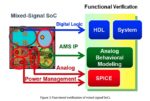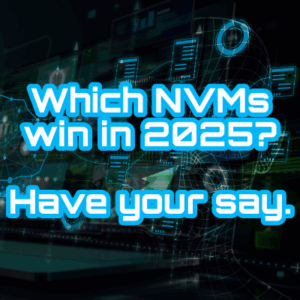TSMC’s Open Innovation Platform’s main objective is to create and promote partnership for producing chips. This year’s OIP event included a presentation on the joint efforts of Silicon Creations, Mentor, a Siemens business and TSMC to produce essential PLL IP for 5nm and 3nm designs. The relentless push for smaller geometries… Read More
Author: Tom Simon
Getting Physical to Improve Test – White Paper
One of the most significant and oft repeated trends in EDA is the use of information from layout to help drive other parts of the design flow. This has happened with simulation and synthesis among other things. Of course, we think of test as a physical operation, but test pattern generation and sorting have been netlist based operations.… Read More
White Paper – Mixed Signal Verification for Nanometer SOCs
The number of touchpoints between analog and digital circuits in high performance SoCs is increasing. This is not a problem because it is possible to implement critical analog blocks directly on nanometer scale digital ICs. However, in many cases digital interfaces or digital feedback circuitry configures these analog blocks… Read More
New Processor Helps Move Inference to the Edge
Many of the most compelling applications for Artificial Intelligence (AI) and Machine Learning (ML) are found on mobile devices and when looking at the market size in that arena, it is clear that this is an attractive segment. Because of this, we can expect to see many consumer devices having low power requirements at the edge with… Read More
Webinar Replay – Designing and Verifying HBM ESD Protection Networks
Every chip needs ESD protection, especially RF, analog and nm designs. Because each type of design has specific needs relating to IOs, pad rings, operating voltage, process, etc. it is important that the ESD protection network is carefully tailored to the design. Also because of interactions between the design and its ESD protection… Read More
DAC Panel – Artificial Intelligence Comes to CAD: Where’s the Data?
Artificial Intelligence (AI) and Machine Learning (ML) are becoming more and more commonplace in our world. We have Siri, Alexa and Google Assistant that understand our voice commands. Vision systems that recognize objects are used for facial recognition, autonomous driving, medical, geographical and many other applications.… Read More
How About a Faster Fast SPICE? Much Faster!
When Analog FastSPICE was first introduced in 2006 it changed the landscape for high performance SPICE simulation. During the last 14 years it has been used widely to verify advanced nanometer designs. Of course, since then the most advanced designs have progressed significantly, making verification even more difficult. Just… Read More
Novel DFT Approach for Automotive Vision SoCs
You may have seen a recent announcement from Mentor, a Siemens business, regarding the use of their Tessent DFT software by Ambarella for automotive applications. The announcement is a good example of how Mentor works with their customers to assure design success. On the surface the announcement comes across as a nice block and… Read More
Waking Up to the Requirements of Voice Activity Detection
There is a famous scene in the 1976 movie Taxi Driver when Robert De Niro’s character Travis is pretending to have a conversation looking in the mirror and repeatedly saying “Are you talking to me?”. I think about this scene every time I use a voice active device – Hey, are you talking to me? Yes, I am, but are you listening?
Voice command,… Read More
The Moving Target Known as UPF
As if engineers did not have enough difficulty just getting everything right so that their designs are implemented functionally correct, the demands of lowering power consumption require changes that can affect functionality and verification. Techniques such as power gating, clock gating, mixed supply voltage, voltage … Read More



















Jensen Huang Drops Donald Trump Truth Bomb on Joe Rogan Podcast